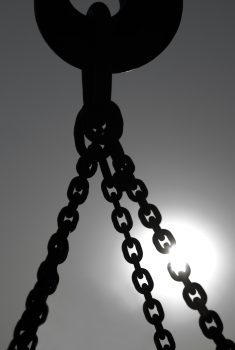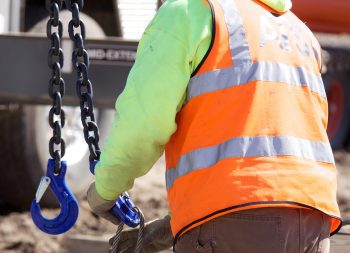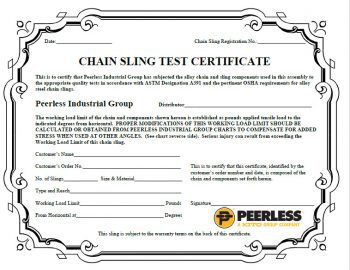Contributed by Bob Kozickie, Technical Sales Support Manager

If you own, use, or are responsible for your company’s alloy chain slings, you are required to have a documented inspected within every 12 month period per OSHA 1910.184 and ASME B30.9. This is contrary to the belief that alloy chain sling inspections are required once every calendar year. That way of thinking would mean that if an inspection is performed in January of one year then the next documented inspection can be delayed until December of the following year. That would equate to a 23 month period between inspections. This, first and foremost, would be a direct violation of OSHA Standards. It is also a long enough time span for any slings which may be close to being removed based on various inspection criteria to continue to deteriorate well beyond the minimum requirements. Depending on the frequency and severity of use, the documented inspection interval frequency may be required to be increased to once every 3 or 6 months.
Preparation and execution of both the end user and chain sling inspectors will lead to an efficient and smooth alloy chain sling inspection. A successful sling inspection is the result of the responsible parties working together.
There are three things which need to be done to ensure that time is utilized to its maximum, while the safety of all concerned is taken into consideration: Accessibility to ALL the alloy chain slings, having the necessary inspection tools, and wearing the proper Personal Protective Equipment (PPE).
Accessibility to ALL alloy chain slings 
Stories are often shared by alloy chain sling inspectors of times when they were working their way through a facility and the sounds of slamming lockers and locking tool boxes preceded them. This is often the workers on the floor hiding their alloy chain slings from being inspected. They have the suspicion that their favorite alloy chain sling will be found to have a defect that would require it to be confiscated with the fear of never seeing it again. Their “personal” chain sling is a utility which is near and dear to their hearts. The thought of having to perform a job without it is almost unfathomable. This fear is understandable for anyone that hasn’t been properly trained on the proper use, care, and maintenance of alloy chain slings. They usually don’t have knowledge of the criteria for removal or the potential dangers which could occur if an alloy chain sling should have a catastrophic failure as a result of these removal criteria going unchecked. This is why it is imperative that every alloy chain sling be available during the inspection.
As mentioned earlier, preparation is a key element for success. Preparedness on the user side involves having ALL the alloy chain slings available and ready to be inspected. Every alloy chain slings’ condition, at the time of inspection, must be documented on the alloy chain sling inspection report. This may involve bringing all the alloy chain slings to a central area for inspection where a hoist or crane is easily accessible or having the staff in each area cease operations so the inspectors can perform their duties. The requirement that alloy chain slings need to be inspected is to ensure the personal safety of all employees, and is one of the two documents that OSHA requires being available for examination.

The Alloy Chain Sing Inspection Report and the Alloy Chain Sling Certificate make up the two OSHA required documents that must be maintained.
Having the necessary inspection tools
The inspectors need to be ready to perform the inspection in a safe and thorough manor. There are several items which should be readily available for the inspectors. The following is a list of recommended items that the inspectors should have readily available during the inspection:
- Chain Sling Inspection Form
- Peerless Alloy Chain Sling Pocket Guide
- Tape Measure
- Wire Brush
- Calipers or Alloy Chain Gage
- Sling Inspection Repair Tags
- Flashlight
- Paint Marker
Wearing the proper PPE
The proper Personal Protective Equipment (PPE) should be used during the inspection to protect the inspector. This includes Safety Glasses, Hard Hat, Gloves, and Steel Toe Shoes. Individual companies may not require all the protection listed; however, experience has proved that having the proper PPE will ensure personal safety.
Once the inspection is complete, arrangements should be made during the planning process to remove all slings tagged for repair or replacement. If the inspectors found a chain that meets the criteria for removal, it should be sent to a qualified repair center as soon as possible. OSHA states that, “slings that are damaged or defective shall not be used”. OSHA also says in reference to removal criteria found during the inspection, “Where such defects or deterioration are present, the sling shall be immediately removed from service.” Therefore, it is in everyone’s best interest to transfer the alloy chain slings to a repair facility immediately after the inspection is completed.
The alloy chain sling inspection should not be looked at as a burdensome mandate. Rather, it should be viewed as a concern for the personal safety of those using the slings to rig loads. They can then be confident that they are using the safest equipment available within their facility or job site. Cooperation and communication before and during the inspection process is beneficial in keeping everyone involved focused on completing a successful alloy chain sling inspection.
See also Chain Sling Inspection Procedures